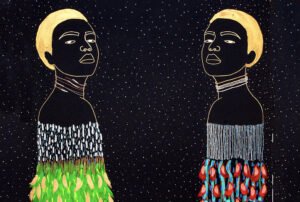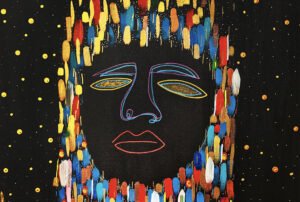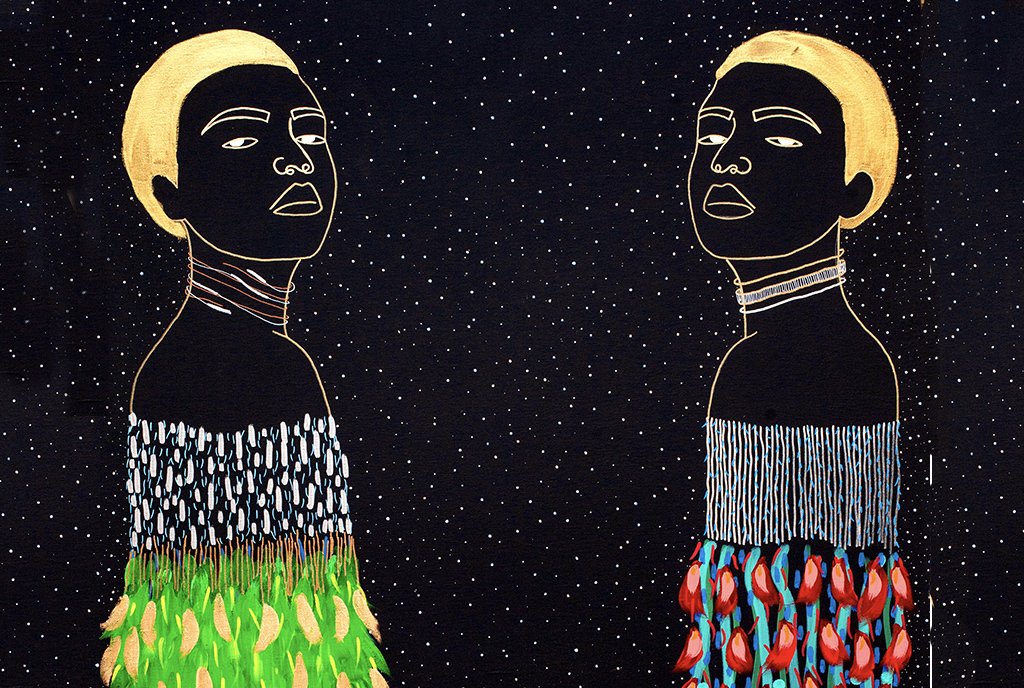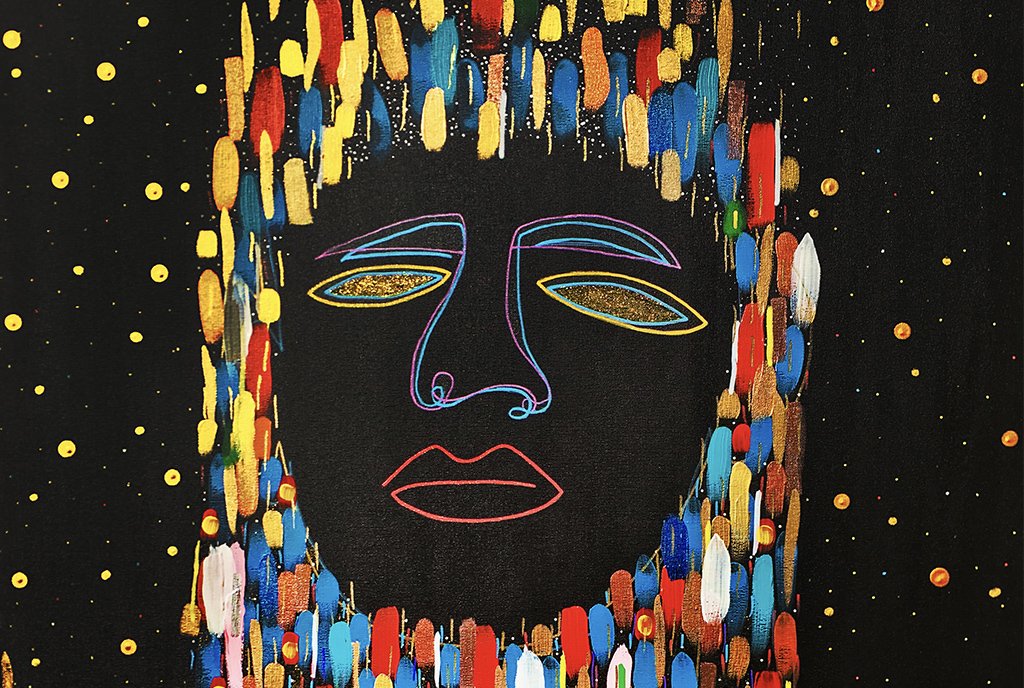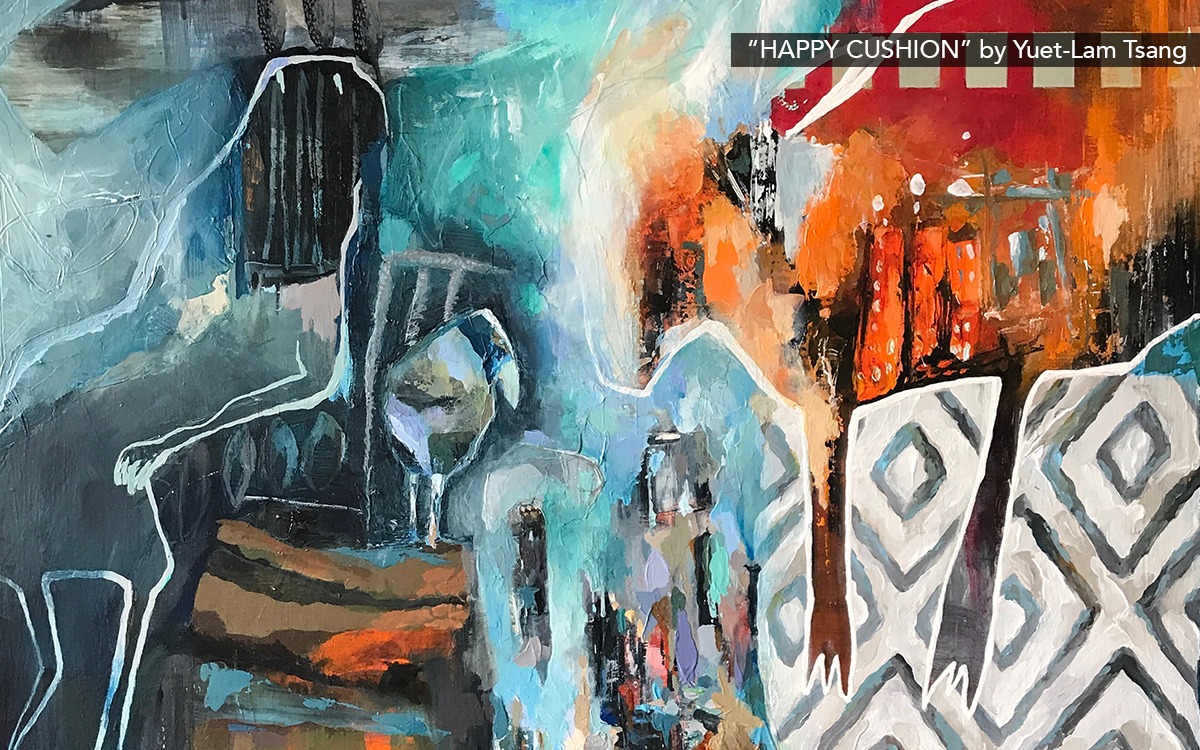
Sky Woman
Long before the world was created, there was an island in the sky inhabited by sky people. One day a pregnant sky woman drops through a hole created by an uprooted tree and begins to fall for what seems like eternity. Coming out of the darkness, she eventually sees oceans. The animals from this world congregate, trying to understand what they see in the sky. A flock of birds is sent to help her. The birds catch her and gently guide her down onto the back of Great Turtle. The water animals like otter and beaver have prepared a place for her on Turtle’s back. They bring mud from the bottom of the ocean and place it on Turtle’s back until solid earth begins to form and increase in size. Turtle’s back becomes Sky Woman’s home, and the plants she’s brought down with her from Skyworld, including tobacco and strawberries, are her medicine. She makes a life for herself and becomes the mother of Haudenosaunee life, as we know it today. 1
We all begin with a story. It is through story that we are connected, not only to each other, but also to our homes, to our lands, to our communities, to our people, to our past, and to our future grandchildren. It is the collection of stories that we are able to hear and witness that will make the whole of our lives and define the shape and character of our community, but also, through the stories, we share and tell and retell what will shape the whole of our future. We organize our worldviews on the patterns of storytelling. The way we tell our stories sets our expectations and influences how we view our lives in relation to our world. Whether our characters are data points or monetary values represented by numbers or by animals and stars, the story is one of management and redistribution of resources, or, as many Indigenous people say, “life sources.” Stories help conceptualize what is possible.
When we talk about economies, we are still telling a story. In mainstream storytelling paradigms, there is always a need for a hero, usually one, and the idea that we can live happily ever after. The villains are named as the ones who set limits or barriers that should and will be overcome by heroes. In capitalism, land, plants, animal beings, people, places are replaced with numerical symbols that create a system of relationships that can be deciphered by understanding the numerical values and often the predetermined rules of engagement. Even further complicated, these systems of numbers are then used to predict future stories using equations, interest rates, but all focused on continued growth, overcoming limitations and barriers. We see this facet of Western storytelling reinforced in iconic stories like the American Dream—and even more stark, in current news reports of new billionaires and the ever epic quest for oil. The message: “There is always more.” In mainstream capitalist storytelling and economy, there is an endlessness that captivates and encourages dreaming, even when this leads to extinction of species, destruction of environments, and separation of community and people into more valuable and less valuable. The less valuable become areas of sacrifice. Entire neighborhoods and communities have become environmental waste zones in the quest for more wealth, space, and money.
There is a place for absence. For nothing. To not consume. For frugalness. This part of the story is just as important, because it establishes limits, ends, and the concept of exhaustion as part of natural and recurring cycles.
Overconsumption, hyperconsumption, and, more recently, continued extraction despite constant calls for slowed development dominate conversations about global, national, regional, and even local economies. The constant need to drill or frack for more oil and find or colonize lands that remain “underdeveloped” are a result of this fundamental focus on continued growth. No growth and absence are the barriers or limits that mark failure and failed economies.
As society continues operating under the cultural understanding of limitless growth, we are destroying the very sources that maintain life. Even more alarming, rather than hinder growth, we find ways to separate and continue consumption: people, life, communities have to become less valuable in order to extract from them. In our mainstream economic equations, we are in constant search to increase the low values and find ever more creative ways to extract value to continue building. Mainstream economies avoid pauses or halts, because those are iconic markers of failure. The mainstream panics at the sign of failure. In more recent discourse around mainstream economies, there is a call for change reflected in conversations around “circular economies” or “responsive economies” or any number of callouts for a changed version of how mainstream society understands economy.
But before we change the equations at the base of mainstream economies, change the idea of limitless growth, we will need to change how we tell, and even listen to, stories. We will need to recognize the importance of, and embrace, absence that is followed by the practice of absence.
In mainstream Western traditions, we are subject to the economy like we are subject to the weather. Yet in Indigenous stories, collectively, we are the story—we are the economy. We influence the world, including life sources, all around us.
Many, if not all, Tribal creation stories recognize the importance of “absence.” This is often referred to as a “darkness” or “nothingness.” It is because of absence that emergence occurs. While Western economies focus on the light, the continued growth, “the absence” is critical in Indigenous understandings on how we manage economies. There is a place for absence. For nothing. To not consume. For frugalness. This part of the story is just as important, because it establishes limits, ends, and the concept of exhaustion as part of natural and recurring cycles. Life sources or resources, if we not are not mindful, can be exhausted.
A Hopi Story
The Creator gathered all of Creation and said:
“I want to hide something from the humans until they are ready for it. It is the realization that they create their own reality.”
The eagle said, “Give it to me, I will take it to the moon.”
The Creator said, “No. One day they will go there and find it.”
The salmon said, “I will bury it on the bottom of the ocean.”
“No. They will go there too.”
The buffalo said, “I will bury it on the Great Plains.”
The Creator said, “They will cut into the skin of the Earth and find it even there.”
Grandmother Mole, who lives in the breast of Mother Earth, and who has no physical eyes but sees with spiritual eyes, said, “Put it inside of them.”
And the Creator said, “It is done.” 2
Sign up for our free newsletters
Subscribe to NPQ's newsletters to have our top stories delivered directly to your inbox.
By signing up, you agree to our privacy policy and terms of use, and to receive messages from NPQ and our partners.
In the Hopi story, as with the Indigenous economies, there is recognition that we, presently, are part of the story—we are the economy. In mainstream economies, the economy is an external system that is controlled by markets, policy, and institutions outside of community, family, and individuals.
In mainstream Western traditions, we are subject to the economy like we are subject to the weather. Yet in Indigenous stories, collectively, we are the story—we are the economy. We influence the world, including life sources, all around us, because we are part of the equation as active participants in economic systems. Essentially, our collective actions, presence, and practice are a form of communication that influences the world around us—including economy, including weather.
In her article “The Pendulum of Climate: A Hopi Story,” Monica Nuvamsa explains:
Farming families work hard to prepare corn for storage for later use, and we are taught to keep at least four years of corn harvests in storage in case of drought or to prepare for major life events such as marriages, births, and ceremony. My household has not had a harvest in nearly three years. I follow the teachings I’ve learned and set aside seed for the next planting cycle, but in the past two years I’ve reduced my portion of seed each year, because the risk of loss in my community heirloom seed stock is too great for me….It is in these times that the teachings come forth and I begin to fully understand why we do this: why we save, why we work hard to have good storage for future years, and why we anticipate the years that may not produce a good harvest. 3
Nuvamsa is describing the practice of absence that influences how their life sources—seeds—are managed. Nuvamsa is a reflection of Hopi, Hopi people, and their stories. The Hopi stories center conversations, relationships, unique gifts that contribute to the whole, and more important, recognize places as important understandings—lessons with stories in and of themselves, places as opportunities to learn about our collective experience in that particular spot. Places are characters in our stories in their own right. Humans are not manipulators of economic or spiritual equation, but are only a small part of the dynamic interactions that occur around humans and the natural world. We humans are only part of the story. As told in both “Sky Woman” and “A Hopi Story,” humans are actually the least aware and gifted of life beings.
Additionally, there is a recognition that “the absence,” “the frugalness,” contains lessons, learnings, and behaviors that cultivate and protect life. There is a clear understanding that life has limits, not limits that should be overcome but rather recognized, acknowledged, and accounted for. This fundamental understanding is the key difference between an Indigenous economy and Western capitalist economies. Moreover, when you have many dynamic Indigenous economies interacting and engaging under the same understanding of limitations as strengths and not limitations as deficits, this is emergence and the creation of symbiotic ideas and environments. Connections among Indigenous communities are valuable not just because they are economically beneficial but also because there is an accountability of shared protection of limits and recognition that each community is responsible for spatial and regional limitations. These connections and understandings are so strong that even through decades after what Anishinaabe scholar Kyle Whyte calls “industrial settler campaigns” 4 that intentionally weakened Indigenous economy, self-governance, and self-determination, there are visible intense material, cultural, and social connections that continue to connect communities. Indigenous trade routes are invisible connections forged over generations, leaving rivulets in the earth between Tribal communities that still very much exist today. We were economic pollinators that have left their evidence in cultural practice in the present. These connections and practices are subtle reminders of our responsibilities to each other, our Tribal communities, and the trade items that found their way from village to village, region to region, and continent to continent.
This is the essence of an Indigenous economy: relationship and community—not just human community—to function in balance. It is community, relationship, and emergence that have value. Ironically, it is community, relationships, and emergence that are rare and much harder to numerically quantify in Western capitalism. Indigenous economy is humbleness, frugalness, and it protects limits. The lessons in Indigenous storytelling, as in Indigenous economies, are clear, important, and practiced: the pauses, the silence, and the stillness are also part of the story; it is the dark stillness that precedes emergence.
Notes
- “Sky Woman,” by Shelley Niro, Kanien’kehaka, 1999; Keller George, Oneida Haudenosaunee, 2001; Alan Brant, Tyendinaga, 2001. There are many variations of this story, and sources differ.
- “A Hopi Story.” There are many variations of this story, and sources differ.
- Monica Nuvamsa, “The Pendulum of Climate: A Hopi Story,” Nonprofit Quarterly Magazine 29, no. 3 (Fall 2022): 14–18.
- I use the term campaigns because these waves of settlement are sustained, strategic, and militaristic. These campaigns include both warlike violence and the tactics for suppressing populations that are used alongside belligerence, from assimilative institutions (for example, boarding schools) to containment practices (for example, reservations) to the creation of dependency (for example, commodity foods). See Kyle Powys Whyte, “Our Ancestors’ Dystopia Now: Indigenous Conservation and the Anthropocene,” in The Routledge Companion to the Environmental Humanities, ed. Ursula K. Heise, Jon Christensen, and Michelle Niemann (New York: Routledge, 2017), 206.



